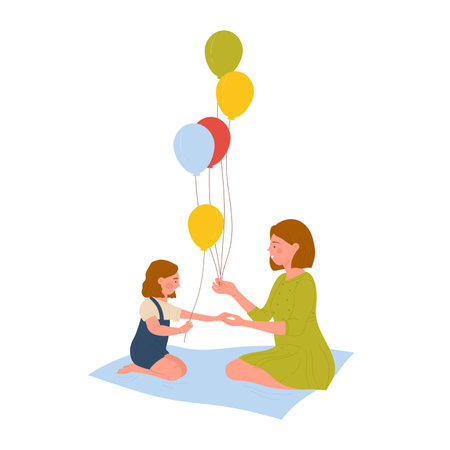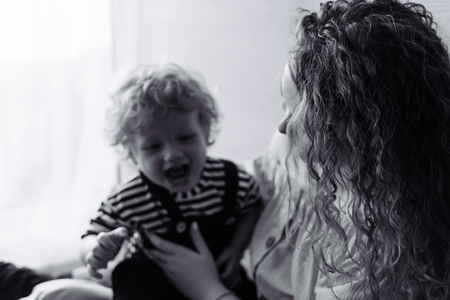1. Introduction: The Power of Music in Early Childhood
As a dad, I used to think music was just background noise or something to fill the silence during car rides with my baby. But I quickly realized there’s a whole lot more going on when we sing “Twinkle, Twinkle, Little Star” for the tenth time in a row. Music isn’t just about fun or soothing cranky moments—it’s actually an amazing tool that kickstarts our kids’ brains and helps them build language skills from day one. When we play music or sing together, we’re giving our babies a head start in understanding sounds, rhythms, and words, all while creating special memories. In this article, I’ll share how music becomes way more than just entertainment—it lays down the foundation for how babies start to make sense of language and connect with the world around them.
2. How Babies Respond to Music and Songs
As a dad, one of my favorite moments is watching my little one light up when music starts playing. You might notice your baby kicking their legs, clapping hands, or even babbling along when they hear a catchy tune. These adorable responses aren’t just cute—they’re signs that your baby’s brain is hard at work, picking up new skills every time you turn on some music or sing a lullaby.
Babies are born with a natural sensitivity to rhythm and melody. Even newborns will turn their heads toward the source of music or a parent’s singing voice. Over time, these reactions get more animated: smiles, squeals, toe-tapping, and even attempts to mimic sounds. All of this is your child’s way of engaging with the world around them, using music as a tool for learning.
What Do These Reactions Mean?
| Babys Reaction | What It Signals |
|---|---|
| Bouncing or rocking | Recognizing rhythm and steady beats |
| Babbling or cooing during songs | Practicing speech sounds and vocal patterns |
| Clapping hands or tapping feet | Developing coordination and timing skills |
| Smiling or laughing at certain tunes | Emotional connection and memory building |
| Mimicking sounds or simple words from songs | Early language imitation and understanding |
When babies react to music in these ways, it’s not just about having fun (though that’s a big part of it!). Each giggle or foot tap means your child is making important connections in their brain. They’re starting to understand the flow of language, how different sounds fit together, and even the basics of conversation by taking turns “singing” with you. So next time your baby gets wiggly during your favorite song, remember—it’s all part of their journey toward becoming a confident little communicator.

3. Building Language Through Singing and Listening
When it comes to helping our babies develop language skills, few things are as fun—and effective—as singing songs together. Catchy melodies naturally grab a baby’s attention, making it easier for them to tune in and focus. But there’s more going on than just a little entertainment! The repetitive lyrics found in classic children’s songs and nursery rhymes play a huge role in language development. By hearing the same words and phrases over and over, little ones start to recognize familiar sounds, which helps them identify new vocabulary later on.
As dads, we might notice our babies light up when we sing “Twinkle, Twinkle, Little Star” or clap along to “If You’re Happy and You Know It.” That’s because these songs break language down into bite-sized pieces—simple rhythms and patterns that are much easier for a young brain to process. The repetition isn’t just about memorization; it’s about creating strong connections in the brain. Each time your child hears the beat or pattern of a song, they’re practicing essential listening skills like recognizing pitch, tone, and the natural flow of speech. This is exactly what sets the stage for talking and understanding language later on.
Plus, singing together is a great way for dads (and moms) to bond with their babies while teaching them how language works. So don’t worry if you’re not the next American Idol—your voice is your baby’s favorite sound, and every silly song you sing helps build a foundation for lifelong communication skills.
4. The Role of Family Jam Sessions
As a dad, I’ve learned that some of the best moments with my kids happen when we let loose and make music together—no fancy instruments needed. Family jam sessions can be as simple as singing along to the radio during car rides or humming lullabies at bedtime. These shared musical experiences aren’t just fun; they’re powerful tools for your baby’s language development and for strengthening your family bond.
Why Everyday Music Moments Matter
When families sing, clap, or dance together, babies pick up on rhythms, new words, and patterns in speech. Even silly songs or hand-clapping games help them recognize sounds and tones they’ll use later when learning to talk. Plus, sharing music creates positive emotions that make those language lessons stick.
Easy Ways to Make Music Part of Family Life
| Everyday Activity | How to Add Music | Language Benefits |
|---|---|---|
| Car Rides | Play favorite songs or children’s playlists; sing along together | Exposure to new vocabulary and repetitive phrases |
| Meal Times | Sneak in a catchy cleanup song or a grace before eating | Encourages listening skills and memorization |
| Bath Time | Sing about splashing or counting rubber ducks | Makes learning numbers and actions fun |
| Bedtime Routine | Share calming lullabies or gentle humming before sleep | Introduces soothing language and emotional connection |
| Play Time | Create simple instruments with pots, pans, or shakers; invent new songs together | Sparks creativity and reinforces word associations |
The Magic of Togetherness Through Music
You don’t have to be a musician to make music a regular part of your child’s life. What matters most is showing up and having fun together. Babies feel your enthusiasm and respond with joy—and that happy connection makes them more eager to listen, mimic sounds, and eventually use those words themselves. In our house, even a five-minute dance party in the living room can turn into a giggle-filled lesson in language without anyone realizing it.
5. Recommended Songs and Activities
As a dad who loves bonding with my kids, I’ve seen firsthand how the right music and fun activities can spark language skills in little ones. When it comes to American family favorites, there are plenty of tried-and-true songs and games that not only bring everyone together but also help babies soak up new words and sounds.
Classic Nursery Rhymes
Singing classic nursery rhymes like “Twinkle, Twinkle, Little Star,” “The Wheels on the Bus,” or “Old MacDonald Had a Farm” is more than just tradition—it’s an interactive way for babies to hear repetitive patterns and new vocabulary. These catchy tunes help babies recognize word rhythm, rhyme, and pronunciation.
Interactive Sing-Along Songs
Try sing-alongs that invite participation, such as “If You’re Happy and You Know It” or “Head, Shoulders, Knees, and Toes.” These songs encourage your baby to follow along with actions and words at the same time, linking movement to meaning. It’s a powerful combo for developing both language and motor skills!
Story Songs and Lullabies
American families often share story songs like “You Are My Sunshine” or “Hush, Little Baby.” The gentle repetition and simple stories not only soothe your baby but also expose them to sentence structure and emotional expression. Plus, the cuddling that comes with lullabies creates positive associations with language time.
Musical Activities for Language Growth
- Call-and-Response Games: Try singing a line from a song and pausing for your baby to babble back. This helps teach conversational turn-taking.
- Homemade Instrument Play: Use pots as drums or shake rice in a plastic container while singing. Babies love making noise—and hearing new sounds boosts listening skills!
- Dancing Together: Put on upbeat children’s songs and dance around the living room. Moving together while singing helps reinforce words through action.
Building Lasting Memories
What really matters is making these moments fun and frequent. Singing together isn’t just about learning—it’s about creating memories your child will treasure forever. Whether you’re belting out classics in the car or winding down with bedtime lullabies, every song is a chance to boost your baby’s language development in a way that feels natural—and genuinely enjoyable—for the whole family.
6. Balancing Screen-Free Music with Modern Tech
As a dad, I know how tempting it is to hand your little one a tablet with nursery rhymes on YouTube, especially when you need a quick break. But when it comes to helping babies develop strong language skills, its important to strike a balance between classic, screen-free singing and today’s convenient tech options.
The Power of Singing Together
There’s something truly special about singing lullabies or silly songs face-to-face with your baby. Your voice, facial expressions, and gestures all help your child connect sounds to meaning. These moments build not only language but also trust and bonding. Try making up simple songs about daily routines—like getting dressed or cleaning up toys—to make everyday words stick.
Smart Use of Technology
Let’s be real: tech is part of modern parenting. Devices can offer a huge variety of music from different cultures and languages, which can broaden your babys listening experience. The key is moderation and safety. Pick high-quality, age-appropriate music apps or playlists (think Spotify Kids or Pandora Kids), and use them as a supplement—not a substitute—for real-life singing.
Tips for Blending Tradition and Technology
- Limit passive screen time for babies under 18 months; instead, listen to music together without video distractions.
- If you do use screens, co-view with your child—sing along and point out words or actions to keep it interactive.
- Create playlists of your family’s favorite songs so you can play music during car rides, playtime, or bedtime—no screens needed.
- Mix in classic folk songs, nursery rhymes, and even songs from your own childhood to keep traditions alive.
By blending the warmth of traditional singing with the variety offered by technology, you give your baby the best of both worlds: strong family connections and rich language exposure that will set them up for success.
7. Conclusion: Making Music Your Parenting Superpower
Let’s face it, being a dad comes with a lot of questions and not always enough answers. But here’s something simple that truly makes a difference—singing and making music with your baby. You don’t need to be the next American Idol or play an instrument like a rock star. Just sharing your favorite songs, humming tunes from your own childhood, or even inventing silly jingles about changing diapers can become powerful moments of connection and learning.
Music isn’t just background noise. It helps your baby learn the rhythms and patterns of language, sparks emotional bonds, and builds their confidence in using new words. Each time you sing or move along to a beat together, you’re strengthening your child’s brain in ways that will pay off for years to come—both in school and in life.
So, let music be part of your daily parenting routine. Sing while driving, during bath time, or on walks around the neighborhood. Make up songs about going to bed or eating veggies. These little moments add up and help your child feel secure, loved, and ready to communicate with the world.
You’ve got what it takes to help your child thrive. So go ahead—turn up the tunes, grab your baby, and make music one of your greatest superpowers as a dad!

